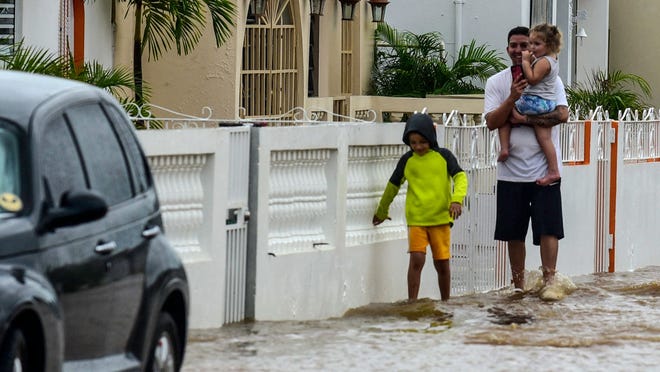Hurricane Fiona is kicking up massive waves as it approaches Bermuda, where weather conditions are expected to deteriorate Thursday before the storm heads toward Atlantic Canada.
Fiona’s march north comes after the storm devastated Puerto Rico and other Caribbean islands, where many residents are still left without power and water days after Fiona hit.
“Significant” waves up to 50 feet were recorded by a National Oceanic and Atmospheric Administration Saildrone in the Atlantic on Thursday.
A hurricane warning is in effect for Bermuda as Fiona, a Category 4 hurricane, approaches, according to the National Hurricane Center. Hurricane conditions are expected in Bermuda starting Thursday night through Friday morning, causing elevated coastal water levels, potential power outages and about two to four inches of rainfall, the center said.
Thursday afternoon, Fiona was located 345 miles southwest of Bermuda with maximum sustained winds of 130 mph and was moving north-northeast at 16 mph, the center said. The storm is expected to pass to the west of the island Thursday night before approaching the Canadian province of Nova Scotia on Friday.
Hurricane Fiona takes aim at Atlantic Canada
While the storm is expected to weaken Friday, Fiona is still forecast to be “a large and powerful post-tropical cyclone with hurricane-force winds” when it hits Canada, according to the National Hurricane Center.
A hurricane watch has been issued for parts of Atlantic Canada, including Nova Scotia, Prince Edward Island, The Magdalen Islands, and the coast of Newfoundland, according to the center.
Those areas are expected to see three to six inches of rain with local maximums of up to 10 inches, causing potentially significant flooding, the center forecast.
Atlantic Canada is expected to “receive the full brunt of Hurricane Fiona’s impacts this weekend” with some areas at risk for “extreme damage,” AccuWeather said.
“Fiona will bring widespread power outages due to high winds, flooding due to torrential rain and isolated storm surge and massive seas offshore and in the Gulf of St. Lawrence,” AccuWeather meteorologist Brett Anderson said.
SEE THE PEOPLE, PLACES IMPACTED:Hurricane Fiona floods homes, streets in Puerto Rico
Tropical system Invest 98L developing
A developing tropical system could spin up into a hurricane in the Gulf of Mexico by the middle of next week, forecasters warned Wednesday.
“This is the most significant threat for the U.S. mainland we’ve had this hurricane season,” AccuWeather chief meteorologist Jonathan Porter said.
Most computer models predict the system, Invest 98L, will be a tropical storm by the weekend in the Caribbean. The models show the system strengthening into a hurricane by early next week. If it becomes a named storm, it would be called Hermine. Read more here.
— Doyle Rice, USA TODAY
HOW TO HELP:Mutual aid, nonprofits to support
Hurricane wind speeds:What is the hurricane wind speed scale? Breaking down how we classify the storms.
Many Puerto Ricans remain without water, food, medicine
Days after Fiona hit Puerto Rico, more than a million people remained without power Wednesday, said Keith Turi, FEMA assistant administrator for recovery. And the Puerto Rico Aqueduct and Sewer Authority said about 45% of its subscribers were still without water service.
More than 1,000 people were in shelters early Wednesday, said Brad Kieserman, vice president of operations and logistics for the Red Cross.
Some health care centers were running on generators, and one cancer hospital had to transfer patients because of power issues, said Alexandra Lúgaro, 41, executive director of the non-profit Foundation for Puerto Rico’s Center for Strategic Innovation and a former candidate for governor. Read more here.
— Kevin Crowe, USA TODAY
Puerto Rico struggles to reach isolated areas
After destroying roads and bridges and causing mudslides, Fiona has left hundreds of Puerto Ricans stranded as authorities work with religious groups and nonprofits to reach areas isolated by the storm in order to provide vital food, water and medicine.
At least six municipalities have areas cut off by the storm, Nino Correa, commissioner for Puerto Rico’s emergency management agency, estimated.
Contributing: The Associated Press
Contact News Now Reporter Christine Fernando at cfernando@usatoday.com or follow her on Twitter at @christinetfern.

















Discussion about this post